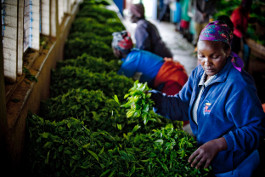Africa Tea Process – Crush, Tear, Branch Out

KENYA CTC-PRODUCING POWERHOUSE DIPS IT’S TOE INTO THE SPECIALTY TEA MARKET.
Of course, the way the world perceives Kenyan tea is largely rooted in CTC black tea. In the CTC process, the tea passes through cylindrical rollers that crush, tear and curl the tea into smaller leaf, the most of which is slated for tea bags. Kenya is one of the world’s leading exporters of tea, accounting for about 20 percent of all tea exporters. Total tea production in Kenya is presently more than 250,000 tons, according to tea consultant (and Kenya native) David Walker, and the vast majority of that is CTC black tea. Mike Spillane, president and owner of California-based G.S. Haly Company, says black teas from Kenya are unmistakable. “Kenya tea has a unique signature,” he says. “If you blend with it, the product generally becomes ‘Kenya’. It has this juniper high note to it that is unique to Kenya and even the CTC—when you get the BP1s, which are the larger CTC cuts—it’s still very nice tea.”
Kenya’s tea history began in 1904, when plants of a Manipuri hybrid were brought from Malawi and planted in Limuru. In 1912, the District Commissioner of Kericho—in Kenya’s southwest—planted tea there, establishing the country’s first viable tea estate. Increasing European settler population during the 1920s developed new clearings of agriculture land, some of which was devoted to tea in the Kericho, Nandi and Sotik districts during the years before World War ll. In 1926, two large overseas companies—Brooke Bond and James Finlay—established interests in Kenya; those firms, plus 10 private estates and two local companies, made up Kenya’s tea industry at the time.
Things changed for Kenya tea in 1954 with Swynnerton Plan, a Colonial agriculture policy in which Kenyan farmers transitioned from subsistence farming to cash-crop production. (Roger Swynnerton was an official in Kenya’s Department of Agriculture.) The plan created thousands of small-scale tea farmers, and the Kenyan government set up the first smallholder tea factory at the foothills of Mt. Kenya in Nyeri, at the center of the country. On Nov. 7, 1957, the initial Nairobi Tea Auction took place, making Kenyan tea available on the international market for the first time.
Walker, who began his tea career in early-1960s Kenya, says that while Kenya became famous for its CTC teas, the country was actually producing orthodox teas during its initial foray into tea production. The orthodox method, which is used for most specialty teas, employs either hand rolling or machines that simulate the hand-rolling process, producing leaves that are more intact than in the CTC process. However, Walker says the decision was made in the 1960s to switch to CTC. “With the advent of the tea bag coming into the United States and the market expanding here, they saw that it would be prudent to go into CTC,” he says, “and that’s what they did. But they became a victim of their own success I guess going forward another 30 years. And now the whole East Africa basically is CTC.”
Kenya struggled for independence from colonial rule in the ensuing years, finally achieving it in December 1963. The following year, small-scale farmers formed the Kenya Tea Development Authority (KTDA). Controlled by new Prime Minister Jomo Kenyatta (who would later become Kenya’s first president), the group’s goal was to build factories and infrastructure that could support the growth of small-scale tea holders. The KTDA was a success, and Kenya tea began to develop into the CTC-producing powerhouse it is today.
Toward the end of the 20th century, the KTDA began working to separate itself from the Kenya government, seeking to have more say in its pay structure and also to expand its reach to compete with other tea-producing nations. In June 2000 the KTDA became a private company; it now manages 65 factories across the country and employs 562,000 small-scale tea farmers who are individual shareholders of the company.
The Specialty Quandary
Much has been made in recent years of the growth in the U.S. specialty tea industry—consumers are excited about its healthful properties, urban teahouses are hip hotspots, and some tea professionals think the Millennial generation may cause tea to explode in the American beverage industry. But when surveying the different origins at play in the U.S. specialty scene, consumers, again and again, see China, India, Taiwan, Japan and Sri Lanka…but no Kenya.
The nation’s absence from the U.S. specialty tea market may not be a permanent one. Royal Tea of Kenya, which is headquartered in New York City, is working on bringing a wider selection of Kenyan teas to America. While the company offers CTC black teas, it also sells orthodox Kenyan tea stretching beyond the familiar black varieties. Royal Tea of Kenya offers orthodox green tea, white tea and a Kenyan specialty called purple tea. Consultant Walker says that because this market is starting to exist from companies such as Royal Tea of Kenya, producers have worked to encourage different tea types to meet specialty demand. “Buyers in the specialty tea market are looking for an exotic origin, a story to tell and something a little bit different,” he says. “So it was logical for Kenya, if they were going to put their toe in the water here in this market that they would also have to produce green tea.”
With different tea plants being grown in nurseries around the country in the early-2000s, Walker was involved in selecting the best clonal plantings suited to orthodox manufacture and building a line of orthodox machines in an existing CTC factory. Further planting inspection led to selecting which plants were best suited for white teas, green teas, oolongs and other tea types. Kenya’s specialty teas are processed at a KTDA factory with machinery Walker helped install about a decade ago when Kenya made its return to orthodox processing. Walker says the factory puts out around 95 percent CTC teas and 5 percent orthodox teas. He adds that while Kenya is producing different tea types now, the country has only just scratched the surface of what it may be able to create. “We got to the point now in Kenya where we can make some very interesting white teas, oolongs, and even a yellow and purple tea. It’s getting there, but it’s still very much in its infancy,” Walker says. More KTDA factories are being earmarked to produce orthodox teas, and Walker says orthodox tea is also being produced in the Kericho area by a large private company.
While pieces are in place for Kenya to generate tea for the specialty market, Walker says the reality is that the market’s small size poses a challenge. “I don’t mean to oversimplify it, but tons of tea, what is the specialty market compared to the whole tea market?” asks Walker. “It’s very small. The specialty tea market is maybe 10 percent, probably less. Although it’s growing at such a huge rate here in the United States, it’s still miniscule when you compare it with the bulk tea market in the world.” Walker says he learned this the hard way when he and his associates couldn’t find enough buyers for the country’s initial batch of orthodox tea. “The first foray of teas coming out of Kenya here was somewhat of a disaster,” he says. “We brought in a container, and it took us months and months and months to sell the tea.”
Still, Walker says it’s worthwhile for Kenya to stay involved in the specialty market as an “area of interest.” He says the bulk of Kenya’s tea exports go to about four origins, and if anything were to happen to these buyers, Kenya would risk losing substantial revenue. “Even though the specialty market is so small, you can’t just shut it out,” he says. “You’ve got to keep your toe in the water.”
Author: Chris Ryan
Magazine: Fresh Cup
Dec. 2011 Tea Almanac

